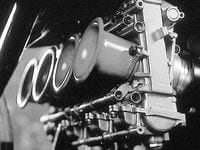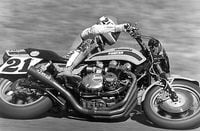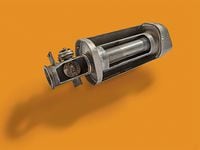Our reader GreenCupcake asks a very wide-ranging question: “You have mentioned jetting and air-fuel ratio a couple of times recently. I still can’t understand why changing the exhaust system on a four-stroke engine typically required rejetting the carb. Why would reducing the backpressure of the exhaust affect the air-fuel ratio at the intake?”
In trying to provide some understanding here, I will begin with one possible assumption which is false, namely that carburetors provide a constant and correct air-fuel mixture to whatever engine they serve. They do not.
This false assumption is most nearly true when a single carburetor supplies a large number of cylinders, as in auto engines. In that case, the intake events of many cylinders overlap, producing a fairly smooth flow of air through the carburetor. In that case a carburetor comes closest to being able to supply a constant air-fuel mixture—because this is steady flow, producing a constant partial vacuum in the carburetor venturi.
But most carbureted motorcycle engines are quite unlike this, as they have a separate carburetor for each cylinder. Thus the flow through each carburetor will be pulsating and intermittent, because the intake stroke’s 180 degrees make up only one-quarter of the four-stroke cycle’s 720 degrees.
The venturi vacuum that causes fuel to flow is anything but constant, and in fact can consist of alternating negative and positive pressures in the carburetor throat as intake flow constantly starts and stops. A good example of this was Norton’s great Manx single-cylinder roadracer. Below about 5,500 rpm, flow through the Manx’s carburetor was constantly being reversed by waves created in its exhaust system, such that it became so rich that it could hardly run. At the time, this phenomenon was called “megaphonitis” because it was especially a problem for engines with megaphone exhausts.
Here’s what was happening: In the rpm band for which the exhaust system was designed, as soon as the exhaust valve began to lift, a strong wave of positive pressure was released into the exhaust pipe. That wave traveled to either the end of the pipe or to the point at which a megaphone was attached, where the flow path began to widen.
In either case, that widening produced a negative wave of low pressure reflected back toward the exhaust valve. In the desired condition, that negative wave arrived during “valve overlap”—the time near top dead center (TDC) on the exhaust stroke when the intake valve has begun to open but the exhaust valve has not yet closed. That negative exhaust wave now evacuates the residual exhaust gas from the volume above the piston, which is replaced by fresh charge entering the chamber from the intake port and carburetor. This early intake flow, driven by the low-pressure wave in the exhaust pipe, occurs even before the piston has started to descend on its intake stroke.
This increases engine torque for two reasons: 1) because residual exhaust is removed from the combustion space before it can dilute the incoming fresh charge, and 2) because by starting the intake process early, cylinder filling is made more complete. This is the main process by which exhaust wave action boosts power in a four-stroke engine.
Now consider what happens at engine rpm lower than that for which the exhaust system is tuned. At lower rpm, the returning negative exhaust wave arrives at the exhaust valve before it has begun to lift. It is closely followed by a positive wave (because negative and positive waves constantly alternate in the exhaust pipe). If by now the exhaust valve has begun to lift, the later-arriving positive exhaust wave stuffs exhaust gas back into the combustion chamber, filling it, and then continues out through the intake port and carburetor.
Carburetors are passive devices which supply fuel any time there is low pressure in the venturi. The carburetor therefore adds fuel to the wave of exhaust gas being blown back through it. It doesn’t care about flow direction.
Finally, the piston moves downward on its intake stroke and the already carbureted exhaust gas that has back-flowed through the carburetor reverses its direction and is drawn through the carburetor a second time, this time toward the cylinder, and picks up fuel a second time. Having been carbureted twice, it is now very rich and consists mainly of inert, incombustible exhaust gas plus fuel. This enters the cylinder and is soon followed by air that has been carbureted normally. At the end of intake, we have a cylinder partly filled with very rich exhaust gas and partly with fresh charge. If it is too rich to fire, we get a misfire (air-fuel mixtures richer than about 10:1 cannot be ignited by a spark). Conditions in the carburetor, complicated by back-blown exhaust gas from the exhaust pipe, produce rough, weak running with a lot of coughing and banging. This is megaphonitis.
As the engine accelerates into the rpm range for which its exhaust pipe is designed, it is again the helpful negative exhaust wave that returns during overlap, so the engine “clears out” and runs strongly because now the exhaust waves are helping cylinder refilling rather than hindering it. The engine runs cleanly to its peak, which in the case of the Manx 500 was close to 7,000 rpm.
Okay, you may say, that’s when there is a megaphone. But my bike has a four-cylinder engine with a collector exhaust system, plus a muffler. Doesn’t this prevent megaphonitis?
Back when the Dynojet company started democratizing dyno testing by selling lots of its rear-wheel roller dynos, Mark Dobeck began to get complaining calls and letters saying his dynos must have a problem.
People dyno-ing four-cylinder bikes with 4-into-1 pipes on them were discovering something that had been there all along: a fairly deep torque flat spot just before engine torque began its climb toward peak torque. In some cases, this flat spot was so bad that some engines couldn’t pull across it. They just sat there on full throttle, gobbling and banging. Jetting the carbs leaner improved running at the flat-spot rpm, but killed engine torque dead everywhere else.
What was happening was the same positive exhaust wave problem that caused megaphonitis—over a range of rpm below peak torque, it was positive exhaust waves returning to the cylinders during overlap, stuffing them full of useless exhaust gas. And just as in megaphonitis, gas being pushed back and forth through the carbs by pressure waves was being carbureted more than once, becoming very rich—maybe too rich to fire regularly. Because of that richness, jetting down improved torque in the flat spot, but made the engine lean everywhere else, weakening its torque or actually causing lean misfiring (mixtures leaner than about 18:1 can’t be fired by a spark either).
One way to reduce this problem is to greatly reduce valve overlap, closing up the “window” through which waves in the exhaust pipe can mess up carburetion as described above. This was the solution on most carbureted streetbikes—very limited valve overlap. This is why tech staff at Ducati called the Diavel’s engine “the 11 degree,” because to give it strong bottom torque, it had been given a very short 11-degree overlap period.
In racing, people didn’t want to lose the torque boost that occurred when it was a negative wave that hit the cylinder during overlap, so a different solution was found—the 4-2-1 exhaust pipe. This system, by providing a second pipe enlargement (where paired head pipes joined) also produced a second source of reflected wave action. That second negative wave could be timed, at the rpm of the flat spot, to cancel out the later-arriving positive wave, reducing its power to pump the cylinders full of exhaust gas. Practically overnight, 4-into-1 pipes disappeared from roadrace bikes—replaced by 4-2-1 exhausts.
Also, a technology using a variable obstruction in the exhaust system (a motor-driven butterfly) was developed to “kill” the undesired positive wave just in the rpm range where it was a problem. Yamaha called its version “EXUP”—but most makers have used similar systems with other acronyms.
Yet another way to keep the performance-boosting combination of longer overlap timing and exhaust wave action is to make valve timing variable. Cam phasers, capable of advancing or retarding cam timing, are fitted to intake and exhaust cams. At low rpm, where exhaust pipe wave action can mess up carburetion, overlap is reduced by retarding the intake cam and advancing the exhaust cam. But as the engine revs up, the cam-phasing devices (which may operate by centrifugal, hydraulic, or electrical means) increase valve overlap to enable the engine to benefit from exhaust wave action.
Carburetor “signal” is the intensity (or lack of it) of the suction pulse produced by an engine’s intake stroke. As an example, I had the experience of using the same-sized carburetor on three different-sized cylinders—a 166cc, a 250cc, and a 350cc cylinder. Because the bigger cylinders produced more vigorous “signal,” those three cylinders required very different main jets in the same 35mm carburetor:
The same effect occurs if you shorten the time during which the intake valves are open, because you are concentrating the suction event in a shorter open time, making it pull a shorter but much deeper vacuum that really gets the fuel moving. Thus with a shorter-duration dirt track camshaft, the strong signal to the carb would require a smaller main jet than if you equipped that same engine with a roadrace cam that held the intake valves open longer.
Some engines have stock exhaust systems that are like holding your nose while you sneeze—they offer a lot of resistance to flow. A classic example is Harley’s undying “Sportster,” which for reasons of traditional style is given little sausage mufflers visually dating to 1957. To make such little mufflers meet sound, they have to be quite restrictive. Because of the increased pressure required to push exhaust gas through them, more exhaust is left in the cylinders at the end of the exhaust stroke. This, by leaving less room for fresh air-fuel mixture, reduces mixture flow enough to weaken the signal at the carb throat, possibly requiring a larger main jet. Change the exhaust to something freer-flowing and you may create a stronger carb signal, requiring a smaller main jet.
The opposite problem affected Yamaha’s popular RD350 two-stroke twins, whose quite restrictive stock air filter acted like having the choke partly on. By requiring the engine to “suck harder” to get the intake air it needed, it created a stronger vacuum in the carburetor venturi, thereby requiring use of a quite small main jet (140 or so) to prevent over-richness, excessive smoke, and sluggish performance. When riders substituted freer-flowing filters, intake vacuum was reduced, requiring use of much bigger main jets—more than 200—to give a correct mixture.
Some fuel injection systems, having exhaust oxygen sensors that allow mixture strength to be measured, are designed to “learn” the mixture required by an altered exhaust system.
Others are purely “mapped,” which means that a 3-D map of injector on-time, throttle angle, and engine rpm has been worked out on a dyno, then stored in memory in every engine’s ECU. If you change the exhaust system, you have to install a new fuel system map to go with it—or go to the dyno and make your own.
Some early fuel-injected motorcycles employed a mass airflow sensor like those used on automobiles. They are able to compensate for changes in operating variables, but did not provide the kind of throttle response motorcyclists had become used to with carburetors.
Because all cylinder-filling variables are interconnected in carbureted engines, tuning for changes in weather or equipment (such as altered exhaust systems) required the skills to tune all carburetor systems. If there is interest, another time I will publish the step-by-step carb tuning method taught to the late rider and engineer Hurley Wilvert by an old Australian speedman.















/cloudfront-us-east-1.images.arcpublishing.com/octane/AUE3NFVRRZDSBIDVUGIYIDQNUI.jpg)
/cloudfront-us-east-1.images.arcpublishing.com/octane/LYR62CH2WNBMHJJVXVATZHOUE4.jpg)
/cloudfront-us-east-1.images.arcpublishing.com/octane/RBCTRGBQYBDK7A6XPG3HKPS7ZQ.jpg)
/cloudfront-us-east-1.images.arcpublishing.com/octane/MQXQRYMZVBCWJIRYP3HEN3SHVE.jpg)
/cloudfront-us-east-1.images.arcpublishing.com/octane/TSPODNNEWRDSVJGUCNQTDG4ADI.jpg)
/cloudfront-us-east-1.images.arcpublishing.com/octane/X5TB7BDV4BA2RPSY54ZGK27RP4.jpg)
/cloudfront-us-east-1.images.arcpublishing.com/octane/REUHOJXRDBGZ5IHBYZCCBCISPA.jpg)
/cloudfront-us-east-1.images.arcpublishing.com/octane/52LGJTCKBFEHDF7S7H4CVUIMGM.jpg)
/cloudfront-us-east-1.images.arcpublishing.com/octane/YMWAIPIPSJAOXOU3QMJMGH37OM.jpg)


/cloudfront-us-east-1.images.arcpublishing.com/octane/EJ6KZRGAYBCVXNL2PJXL37UVWQ.jpg)
/cloudfront-us-east-1.images.arcpublishing.com/octane/AAN4TI76M5H5JMUVEIGASWXBDU.jpg)
/cloudfront-us-east-1.images.arcpublishing.com/octane/P3RXD2UCPFF37CMB7CHPVKXORY.jpg)
/cloudfront-us-east-1.images.arcpublishing.com/octane/VZEG2EJI2RDFZNHLRZMU56MD3Q.jpg)
/cloudfront-us-east-1.images.arcpublishing.com/octane/GVJQO5FFOFBWNGODOBRB4FBAW4.jpg)
/cloudfront-us-east-1.images.arcpublishing.com/octane/BIVAK2SFIBDJJM25E7I5VU2FJE.jpg)
/cloudfront-us-east-1.images.arcpublishing.com/octane/CH5VX52UG5CFHOVH5A6UYEFWWA.jpg)
/cloudfront-us-east-1.images.arcpublishing.com/octane/ZVGJNGZRU5C33N7KN23BBFKSC4.jpg)


/cloudfront-us-east-1.images.arcpublishing.com/octane/CZ5OM3E43ZEXJHY7LCYXCHLIKI.jpg)
/cloudfront-us-east-1.images.arcpublishing.com/octane/DF5T4K5KPZFJXFCTGPYR77PKJM.jpg)
/cloudfront-us-east-1.images.arcpublishing.com/octane/RMCT2KVQBJHBZMRTSLOVPMOILU.jpg)